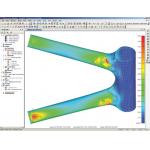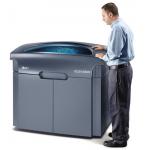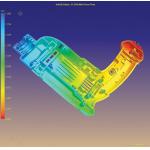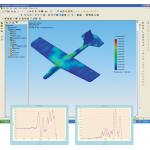March 1, 2006
By DE Editors
FEA Material Library Benefits NEiWorks Users
Noran Engineering (Westminster, CA) announced that users of its NEiWorks embedded FEA system for SolidWorks can now access and import material properties from data provider MatWeb (Blacksburg, VA).
 |
| NeiWorks from Noran Engineering. |
MatWeb has developed an online searchable database of more than 50,000 materials that contains property values on the full range of engineering thermoplastics, thermosets, metals, super alloys, ceramics, semiconductors, fibers, and other engineering materials. The MatWeb information can be downloaded easily and accurately into NEiWorks.
The library allows product development engineers to test designs virtually using FEA for structural, thermal, and dynamic performance. Access to the database will help speed up product design cycles and improve quality by providing a fast way to identify and validate the exact material needed to optimize a part design and satisfy quality assurance requirements.
 |
| DE Readers’ Choice Winner—NEiWorks |
For more information, visit Noran Engineering or MatWeb.
The Material Properties Library for NeiWorks from Noran Engineering and MatWeb garnered the most votes in our December 2005 issue. Vote for your favorite product from this issue by going to the last page of this section.
Unlock Geometry from Layers of Dumb Data
Kubotek USA (Marlborough, MA) offers REALyze, an integrated set of software tools developed to help engineers and designers understand and edit dumb geometry. Kubotek says it is bringing this product to market to help CAD/CAM professionals share imported models between disparate CAD systems in an effort to streamline the design and manufacturing process. REALyze has been developed to complement and coexist with popular CAD platforms.
Engineers and designers need to be able to access and edit any file, regardless of its origin. Time-to-market pressures are constant. REALyze provides a dynamic environment in which designers and engineers, when confronted with a model in an unfamiliar format, can access the model’s geometry in order to work with the file and avoid having to recreate work. REALyze allows designers to cut overall time to market.
CAD interoperability has been documented as a major issue in the manufacturing sector. Kubotek’s recent industry surveys (available at kubotekusa.com/ products/survey_1) have shown that more than 75 percent of survey respondents receive fewer than half of external CAD models in a preferred format. Fifty percent of respondents said they needed to use three or more CAD tools per month. The cost of maintaining multiple systems continues to rise.
REALyze takes advantage of the rich interoperability foundation developed for Kubotek’s flagship KeyCreator software. This allows REALyze to recognize geo- metric entities across proprietary formats, providing the basis for the product’s advanced translation and repair capabilities. At its core, REALyze has the ability to perform geometric search and pattern and feature discovery.
The REAL architecture powers REALyze with three essential elements necessary to fix models without recreating or attempting to translate a file’s entire history tree: translation, healing, and editing capabilities.
REALyze will be licensed as a single seat or enterprise concurrent use license. Shipments began in late February. For more information, click here.
Stratasys (Minneapolis, MN) introduced the Eden350 and 350V PolyJet prototyping systems as successors to its Eden333. The 350 and 350V are built on a new high-performance platform introduced last November. The systems have a larger build envelope than the 333 that measures 13.8 in. x 13.8 in. x 7.9 in. They also accept large 3.6 kg material cartridges, allowing larger volumes and longer unattended jobs. Both offer increased resolution, and the 350V has a double-speed setting.
The Eden350V has speed and resolution settings that allow users to choose between the highest model quality and highest build speed. Both settings offer an x, y, and z resolution of 600 x 600 x 1600 dpi respectively, constituting a 100 percent increase in y resolution over the Eden333.
 |
| Eden350 prototyping system from Stratasys. |
In its high-speed mode, the 350V effectively doubles the build speed of the old system. The speed increase is achieved by changing horizontal resolution to 30-microns (0.0011 in.). In its high-quality mode, a resolution of 16-micron (0.0006 in.) layers enables detail and surface finish smoothness. The Eden350V has two modeling-material and two support-material cartridges, which increase the unattended build time by 360 percent.
Both 350 systems work with all available PolyJet material families, including the Tango, Vero, and translucent FullCure lines. For more information, visit click here.
The new APEXX 4 workstation from BOXX Technologies, Inc. (Austin, TX) is designed specifically for creating complex effects and detailed computer-generated (CG) objects. The four dual-core AMD Opteron processor architecture of the APEXX 4 offers design engineers who require high-performance graphics and analysis abilities another choice that, says the company, reflects the next generation of workstations.
A true 64-bit personal workstation with as much as 64GB of memory, APEXX 4 is intended to boost the efficiency of design engineers, analysts, and digital artists working on complex real-time simulations and animations, and on complex effects and detailed CG objects.
The APEXX 4 is based on the integration of nonproprietary PC technologies and delivers a high-end computing experience that was the exclusive domain of proprietary Unix workstations. The company is engaged with a number of independent software vendors to ensure that the APEXX 4 is compatible with a broad range of applications.
For more information, click here.
SolidPartners Inc. (Emeryville, CA) launched ActivaultWeb advanced file management system at SolidWorks World 2006 in Las Vegas in January. ActivaultWeb is based on the file management tools and technology of the Activault Advanced File Management software for SolidWorks and is designed to allow safe, authorized sharing of SolidWorks files across a Web browser.
Activault is said to be an easy-to-use, advanced file management (or PDM) technology that operates seamlessly within SolidWorks, allowing engineers to protect, manage, and share design files easily and rapidly. It can download files from the secure vault, which can then be accessed with a URL that can be sent to a recipient via e-mail. Using ActivaultWeb, the recipient can then view, measure, and comment on approved SolidWorks files. It is intended to let those in the production process see design files earlier in the process, make comments, place estimates, and plan ahead.
ActivaultWeb works as a thin-client technology so end-users do not have to download software other than a standard web browser. ActivaultWeb enables online review of design data; the download of files for local review or NC programming; searches for files based on properties; viewing of configuration data; review of a file history; and e-mail links to additional users for further review.
Price: $2,500 (per server). For more information, click here.
TekSoft (Scottsdale, AZ) says its CAMWorks 2006EX release features a new module for multiaxis machining that allows a wide variety of shops and manufacturing facilities to take advantage of 4- and 5-axis machines. TekSoft says CAMWorks 2006EX provides job shops greater productivity and equipment flexibility, giving shops the ability to machine products of better quality.
CAMWorks 4- and 5-axis simultaneous machining enables the use of toolpaths across complex shapes that could not be machined on 3-axis machines. This includes high-performance automotive port finishing, impellers, turbine blades, cutting tools, 5-axis trimming, and undercut machining in mold and die making. CAMWorks 4-axis simultaneous machining is designed for complex rotary applications such as camshafts, extrusion screws, and blades.
Performance enhancements include a reduction in file size of more than 40% for parts with large volumes of advanced 3-axis toolpaths; improvements in the 3-axis calculation speed from 20 to 50%; a reduction in the memory required to display toolpaths; and a cut in time needed to start simulations for parts containing large volumes of toolpaths.
New features and cutting strategies include automatic creation of perimeter features based on the boundary of the part model in mill and Wire-EDM; rough mill high-speed machining options for generating toolpaths with round corners and S-curve links; finish mill options for final cuts and numerous new bottom finish options; new mill toolpath method to optimize features in pocket-in and pocket-out patterns; and pencil mill strategy for 3-axis rest machining.
Latest SIMPOE-MOLD Unveiled at SolidWorks World 2006
SIMPOE (Torcy, France) pulled the wraps off the latest version of SIMPOE-MOLD at SolidWorks World 2006. According to SIMPOE President Alain DuBois, the new release is integrated, scalable, and offers full functionality for parts designers and plastic specialists. Perhaps dramatically, he called the program “the missing link in the plastics industry for companies implementing a collaborative product development process, within a product lifecycle management strategy.”
 |
| A SIMPOE-MOLD plastics simulation. |
New features of the plastic injection-molding simulation software include an improved built-in mesher, with automatic optimization of the mesh of the CAD model files imported directly from the CAD program. It lets the user maintain the option of manually controlling mesh parameters. Other improvements are an updated material and plastic resin data library; a built-in editor for designing, selecting, and analyzing runners and cooling channel geometries quickly and easily; and direct integration of SIMPOE-MOLD with CAD software. SIMPOE-MOLD is available in several languages through a worldwide network of specialized VARs.
For more information, click here.
The Numerical Mathematics Consortium (Austin, TX) announced the availability of its preliminary technical specification, which outlines more than 250 numerical mathematical functions the consortium plans to standardize. The Numerical Mathematics Consortium (NMC) identified these functions in order to establish standardization in numerical algorithm development that would enable portability and reuse among tools, platforms, and disciplines with an emphasis on matrix computations.
The 250-plus functions are grouped under 14 classes: approximation, integration and interpolation; Boolean functions; relational operators; elementary functions; linear algebra; math constants; matrix generation; matrix operators; membership functions; polynomial functions; set operators; special functions; statistic functions; and vector analysis.
The NMC is a nonprofit organization of vendors and individuals in industry and academia working to reduce overall cost of algorithm development and reuse by establishing an open math semantics standard. They advocate that standard specification would ensure algorithm portability across platforms and enable compatibility among applications through standardizing core mathematical definitions, algorithm interchangeability and function semantics.
The completion of this phase of the process—the identification of these functions—will allow the NMC to focus on the next phase: the standardization of the semantic definitions of these core functions.
For further details, click here.
Structural Research and Analysis Corp. Redesigns COSMOSDesignSTAR 2006Structural Research and Analysis Corp. (SRAC/SolidWorks Corp.; Santa Monica, CA) has released COSMOSDesignSTAR 2006, a completely redesigned version of the stand-alone design analysis program that works with virtually all CAD programs. In addition to a new user interface, COSMOSDesignSTAR 2006 has new tutorial features as well as several new analysis capabilities, including virtual connectors for assemblies, drop tests, and fatigue life. Despite these changes, COSMOSDesignSTAR 2006 is fully compatible with COSMOSDesignSTAR 4.5. (See the review in the March 2006 DE’s Elements of Analysis.)
 |
| COSMOSDesignSTAR 2006. Click image to enlarge. |
To help design engineers analyze the effects of impact on their designs, COSMOSDesignSTAR 2006 now also enables drop test simulation for both parts and assemblies. Greater ease-of-use comes from an updated GUI, and a number of tools to help novices and infrequent users use the software. These include such features as a Quick Tips guide that walks users through both the GUI and functions. A What’s Wrong utility helps users analyze errors and learn whether such inputs as loads, restraints, and mesh are valid. In addition, a wizard called Analysis Advisor takes beginners or casual users through the analysis setup and postprocessing stages, and answers such questions as what study type to use, what to do if a mesh fails, and how to interpret results.
The new release has also added mixed meshing, making it possible for engineers to simulate thick and thin components with a combination of solid elements for thick bodies and shell elements for thin parts. The addition of h-adaptive meshing enables the program to converge to a correct solution by automatically refining the mesh in critical areas until the solution converges.
COSMOSDesignSTAR 2006 also offers fatigue life analysis. This new analysis tool gives users the ability to perform studies on assemblies that contain different material properties, and also to be more accurate in predicting a product’s lifespan by using actual loading conditions in the simulation. Fatigue life analysis tools include Rainflow charts to help users determine the effects of small stress cycles in their loading history, and possible effects over the life of the product.
COSMOSDesignSTAR supports SolidWorks 2006 as well as Solid Edge 18, Autodesk Inventor 10, Pro/E Wildfire 2, and CATIA V4/V5. COSMOSDesignSTAR also supports Parasolid, ACIS, and other CAD formats via STEP and IGES.
For complete details, click here.
Alienware Corp. (Miami, FL) introduced two new lines of workstations that use the new Intel Pentium processor Extreme Edition 955. Both workstations—the Area-51 7500 and the ALX—make use of Intel’s latest dual-core processor with HyperThreading Technology.
The Pentium processor Extreme Edition is expected to give high-end modelers, analysts, design engineers, game professionals, and others an increase in realism and richness in graphic performance by enabling increased bidirectional bandwidth to the graphics and I/O interfaces.
The Area-51 7500 and ALX permit users to create virtual “partitions,” isolating multiple user environments, such as dedicating resources to graphics applications or simulation environments with Intel Virtualization Technology. Thus, users who require multitasking performance will be able to create, edit, and encode graphically intensive files while a virus scan runs in the background without degrading performance. In addition, the Intel Pentium processor Extreme Edition 955 includes Intel High Definition Audio.
Subscribe to our FREE magazine, FREE email newsletters or both!
About the Author
DE’s editors contribute news and new product announcements to Digital Engineering.
Press releases may be sent to them via [email protected].






